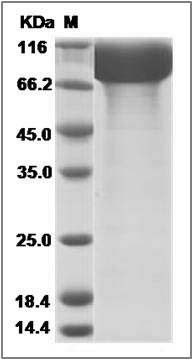-
Product Name
Rhesus CD10/Neprilysin (His Tag) recombinant protein
- Documents
-
Description
The cluster of differentiation (CD) system is commonly used as cell markers in immunophynotyping. Different kinds of cells in the immune system can be identified through the surface CD molecules which associating with the immune function of the cell. There are more than 320 CD unique clusters and subclusters have been identified. Some of the CD molecules serve as receptors or ligands important to the cell through initiating a signal cascade which then alter the behavior of the cell. Some CD proteins do not take part in cell signal process but have other functions such as cell adhesion. Cluster of differentiation 10 (CD10), also known as Neprilysin and neutral endopeptidase, is a member of the CD system. CD10 is a zinc-dependent metalloprotease enzyme that had function to degrade a number of small secreted peptides such as the amyloid beta peptide. It exist as a membrane-bound protein and have high concentration in kidney and lung tissues. Mutations in the CD10 gene can induce the familial forms of Alzheimer's disease, providing strong evidence for the protein's association with the Alzheimer's disease process. CD10 is also associated with other biochemical processes.
-
Protein name
Neprilysin
-
Uniprot ID
F7H3Y6
-
Gene Name
MME; EGK_11980
-
Source/Expression Host
Human Cells
-
Expression Plasmid/cDNA
A DNA sequence encoding the rhesus MME (NP_001247743.1) (Tyr52-Trp750) was expressed with a polyhistidine tag at the N-terminus.
-
Protein Species
Rhesus
-
Molecular weight
The recombinant rhesus MME comprises 718 amino acids and has a calculated molecular mass of 82.1 KDa.
-
Purity
> 90 % as determined by SDS-PAGE
-
Validations

Cynomolgus CD10 / Neprilysin / MME Protein (His Tag) SDS-PAGE
Related Products / Services
Please note: All products are "FOR RESEARCH USE ONLY AND ARE NOT INTENDED FOR DIAGNOSTIC OR THERAPEUTIC USE"
